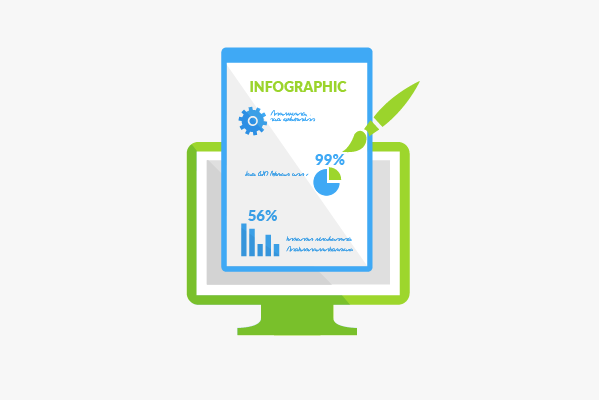Infographic
Infographics are graphic representations used to clearly illustrate complex relations and comprehensive data sets in a manner that is quick and easy to grasp, understand, and interpret.
Requirements for an infographic
The most important requirement of an infographic is that the interrelations between the various aspects be illustrated correctly. Here, it is important to make sure that the data used are researched properly and that the interrelations are correct. The reader should be drawn to the graphic and guided through it automatically.
A good infographic is self-explanatory and does not require additional description in the form of text. It can therefore be shared online without restrictions and embedded in a new context without it losing its significance.
Applications
Infographics are used to graphically illustrate different forms of data material. These include:
- chronological correlations
- comparisons
- family trees
- business organization
- instructions and procedures
- statistical data
- charts
- weighting of advantages and disadvantages or opportunities and risks
- spatial interrelations and local circumstances
Advantages and disadvantages
The main reason why infographics are used is because they help make complex data sets comprehensible within a very short time. Particularly for online use, they come in handy when you want to quickly provide users the information they are looking for. Other advantages of infographics include:
- breaking down complex data sets into smaller pieces of information
- better understanding
- easier to remember through the combination of images and text
- infographics are often shared on social media
- diverse applications (e.g., on websites, press releases, brochures, etc.)
One disadvantage of infographics is the high amount of time required for preparation. The design alone is very complicated, and then there is the actual graphical work. Another problem is that infographics often come out as being textless. This is because Google is unable to read the text contained in the graphics. Furthermore, integrating clickable links is not easy. One other thing that is often problematic is the fact that most applications only work with updated data. As a result, the data are quickly outdated and have to be replaced with new material. This means that infographics only remain interesting for a comparatively short time despite the high costs.
Creation of infographics
Before an infographic can be created, the required facts and data must be researched, selected, sorted, and structured. The next step involves developing an appropriate concept and building a story in which the data should be embedded. Only then does the actual work take place, the designing.
Graphics software
One needs appropriate graphic software in order to create an infographic. For those who are not that familiar with web design, several free or paid web tools that simplify the creation of infographics are currently available.
- Infogr.am (creation through drag and drop)
- PiktoChart (customization of colors, fonts, and graphic elements of different themes)
- Wordle (creation of word clouds, similar to tag clouds)
Importance for online marketing
Since good infographics are more frequently shared online, they can be a good source of traffic and links. Furthermore, they can also be used to improve the website’s ranking. For this reason, infographics make up an integral part of the online marketing mix for many site operators.
However, infographics are increasingly being created purely for marketing purposes and often do not live up to their actual claim. This is why Matt Cutts explained in an interview that, in the future, it would be conceivable to have links that result from devalued infographics. Cutts criticized that many infographics are often researched poorly, riddled with errors, and often confuse the reader. [1]
References
- ↑ Matt Cutts and Eric Talk About What Makes a Quality Site Stonetemple.com. Accessed on 07/01/2014

